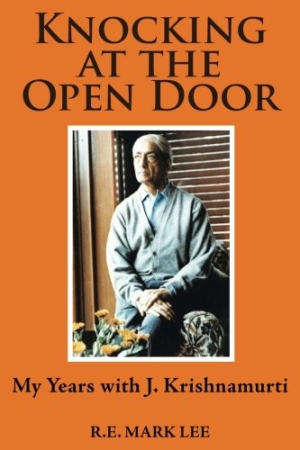Knocking at the Open Door
My Years with J. Krishnamurti
This is an important contribution to the literature on a great man who worked tirelessly to bring forth his vision of an enlightened humanity.
Jiddu Krishnamurti (1895-1986) was a teacher, author, and public speaker whose vision for humanity reached far beyond striving for individual liberation. He devoted his life to transforming the consciousness of the human species. In Knocking at the Open Door: My Years with J. Krishnamurti, R. E. Mark Lee, who not only spent years serving in Krishnamurti’s foundations and schools but was also his trusted friend, details the historical events, conversations, and memorable interactions they shared.
From the beginning of his association with the great teacher, Lee kept careful diaries that hold a wealth of information on Krishnamurti’s philosophies and teachings, and give rare glimpses into the character of the man who influenced so many lives across the globe. “The goodness and presence of Krishnamurti had a life-changing impact on me and on others who were privileged to be associated with him,” writes Lee, adding that Krishnamurti “lived on the cusp of two worlds: the seen and the unseen,” and “was himself what he taught.”
Lee’s book, based on upon these diaries, spans continents and cultures. He begins with his own youth in the 1950s as part of California’s laid-back surfer culture; moves on to being personally invited by Krishnamurti to work in India as a teacher of English; and culminates with his return to California, the establishment of the Oak Grove School, and Krishnamurti’s death.
Lee writes from the vantage point of a close working associate to describe Krishnamurti’s thoughts on the nature of true education and how it should foster real psychological change; how to understand fear and authority; how conditioning creates racial, religious, ideological, and nationalistic divisions; how the drive to “become someone” creates punishing conflict; how overemphasis on the intellect and cognition can result in fragmented personalities; and why teaching is the highest profession and is religious in nature.
Also included are vignettes of the master’s day-to-day life and his interactions with the cultural icons of his time. Charlie Chaplin, Greta Garbo, Hume Cronyn, Aldous Huxley, Lili Kraus, Bertrand Russell, and D. H. Lawrence make appearances, as does the Dalai Lama, who had sought Krishnamurti’s advice on the education of Tibetan youth.
Lee’s writing is sensitive, conversational, and characterized by attention to detail and vivid descriptions of people and places. His depictions of India, a land that is overwhelming in size and population and weighted by a ten-thousand-year-old philosophy, are at once delicate and powerful. His respectful inclusion of some of Krishnamurti’s surprising contradictions in character and behavior brings the great man to life in all his humanity.
Lee balances his personal observations and reflections, conversations with Krishnamurti, and discussions of philosophy, education, and religion very well, giving the work good pacing and flow. The book’s layout and design facilitate pleasurable reading, but while the photos included to enhance the text are clear and bright, the names of the people, places, and events they show are missing.
R. E. Mark Lee has made an important contribution to the literature on a great man who worked tirelessly to bring forth his vision of an enlightened humanity, inviting people “to step through the open door into a world of great beauty, love, wonder, and understanding—all brought about by the irreversible change in outlook and perception of the new mind.”
Reviewed by
Kristine Morris
Disclosure: This article is not an endorsement, but a review. The publisher of this book provided free copies of the book and paid a small fee to have their book reviewed by a professional reviewer. Foreword Reviews and Clarion Reviews make no guarantee that the publisher will receive a positive review. Foreword Magazine, Inc. is disclosing this in accordance with the Federal Trade Commission’s 16 CFR, Part 255.

